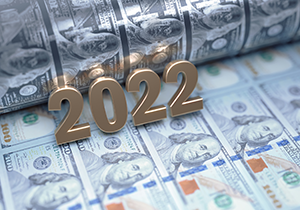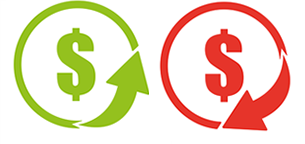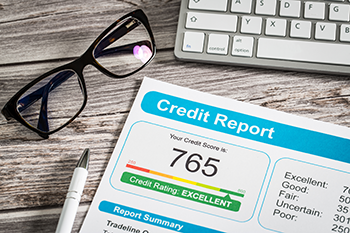 A new year. New resolutions. Here are five ideas to consider to help improve your financial health in the upcoming year.
A new year. New resolutions. Here are five ideas to consider to help improve your financial health in the upcoming year.
- Save more for retirement. Plan for the future by feathering your retirement nest egg. For instance, you can contribute up to $20,500 to a 401(k) account in 2022, plus another $6,500 if you’re age 50 or older. Plus, your company may provide matching contributions up to a stated percentage of compensation. And you can supplement this account with contributions to IRAs and/or other qualified plans.
- Update your estate plan. Now is a good time to review your will and make any necessary adjustments. For example, your will may need to be updated due to births, deaths, marriages or divorces in the family or other changes in your personal circumstances. Also review trust documents, powers of attorney (POAs) and healthcare directives or create new ones to facilitate your estate plan.
- Rebalance your portfolio. Due to the volatility of equity markets, it’s easy for a portfolio to lose balance against your investment objectives. To bring things back to where you want, review your investments periodically and reallocate funds to reflect your main objectives, risk tolerance, and other personal preferences. This will put you in a better position to handle the ups and downs of the markets.
- Review, consolidate, and lower debt levels. One sure-fire method for improving your financial health is to spend less and save more. Start by chipping away at any existing debts. This may mean giving up some luxuries, but it’s generally well worth it in the long run. Pay extra attention to debts with high interest charges like credit card debt. If possible, consider consolidating several of these debts into one or two obligations if you can lower your interest rate in the process.
- Contingency planning. No one can foresee every twist and turn that 2022 will take. To avoid potential financial hardship, look to improve your emergency fund by setting aside enough funds to pay for six months or more of your expenses in case of events like a job loss or a severe health issue.
These five tips can help you thrive in 2022!
How to tell the difference
 Not all debt is created equal. Knowing the difference can change the way you look at your spending.
Not all debt is created equal. Knowing the difference can change the way you look at your spending.
Good debt adds value
Good debt often leads to financial growth, because the product or service being purchased adds more value than the debt that comes with it. Student loans are usually an example of good debt because the related education allows you to earn more income.
Some purchases result in value more directly. Taking on a mortgage, for example, can be valuable simply by giving you access to a place to live all while building equity. Additionally, a mortgage is often considered good debt because your property can be used as collateral for other debt once you’ve made some payments on it, or your home has gained in market value. Even better, good debt often comes with a tax deduction on the interest you pay on things like your mortgage or student loans.
Bad debt adds expense
Credit card debt is almost always bad debt. Not only are interest rates on credit cards higher than most other types of debt, but most purchases made with credit cards are for things that do not contribute to personal financial growth. In fact, interest expense is so high that credit card companies are now legally required to display the cost of this debt directly on their billing statements. Auto loans are another example of bad debt, because cars usually lose value quickly, often leaving more money owed on the debt than the car is worth! But even good debt can turn bad if there is too much of it. Take out too large a mortgage and you may struggle to make payments!
Debt always means higher cost
Debt’s big benefit is allowing you to pay for something over time. The cost of any purchase using debt MUST include the interest expense of taking on that debt. You can compare that with the option of saving up money and then making the purchase without interest. Is the extra interest worth the benefit? Comparing the cost of the purchase with interest, to the value you stand to gain by purchasing the asset, can help you determine whether using debt is a good or bad choice for you.
Final thoughts
Here are some ideas on how to manage good versus bad debt.
- Consider carefully what you can afford and make a plan for how you will pay off any debts before you take on the debt.
- Never carry a balance on a credit card unless it is an emergency. Pay the balance in full every month.
- Calculate the entire cost, including interest, of anything you purchase using debt. This is the REAL cost of an item.
- Use savings, whenever possible, to purchase goods and services that would otherwise be considered bad debt.
- Pay off high interest debt first.
- Financial growth is often the key measure for defining good versus bad debt, but not always. Other factors, like personal interest, growth, and well-being can also be measures for your debt decisions, as long as you can truly afford the payments.
Reach out for help if you aren’t confident whether a potential debt will be beneficial or harmful. Making the right choice could save you money.
You’re ready to take out a loan to buy a house, a car or get a credit card. You fill out the application and wait to hear back from your bank on its decision whether to loan you the money.
 And then you get the dreaded phone call. Your credit score wasn’t high enough to approve the loan! Was there anything you could have done to get a higher credit score?
And then you get the dreaded phone call. Your credit score wasn’t high enough to approve the loan! Was there anything you could have done to get a higher credit score?
Getting and maintaining a high credit score is just like playing a game. But just like any game, you first need to understand the rules so you can create a winning game plan. Here are the rules of the credit score game you need to understand so you can get the highest score possible.
- Rule 1 – Pay your bills on time (Comprises 35% of your credit score equation). Payment history is the most important component of your credit score and is pretty straightforward – it’s a record of whether or not you’ve paid your bills on time.
Action: Don’t be late paying your bills! A one-time late payment may not affect your score, but multiple late payments will drag down your score. Even better, understand what vendors report your payment history and which ones do not.
- Rule 2 – Refrain from maxing out your credit (30%). Just because you have a $10,000 credit limit doesn’t mean you should use it all. Using close to or all of your credit limit signals to lenders that you may be a high-risk borrower. Insurance companies also love to use high-limit spending as a reason to increase your home and auto insurance, so be forewarned!
Action: Don’t use more than 25% of your available revolving credit, and pay the outstanding credit card balance in full each month.
- Rule 3 – Build a long history of using credit responsibly (15%). Lenders want to see a track record that you can handle being entrusted with a credit limit. If you have old credit accounts that are still open and in good standing, that signals your trustworthiness, which is reflected in a higher credit score.
Action: When you open a credit account, keep it active for as long as possible. If you stop using an account, consider leaving that account open, but only if it will help your score and not hurt you in obtaining new credit.
- Rule 4 – Use multiple types of credit (10%). Lenders like to see you with both revolving debt (credit cards) and installment debt (car and house loans).
Action: If you have a low credit limit, request a limit increase. Many banks will honor the request, especially if you’ve had a history of making on-time payments. If you don’t have a history of using installment loans, consider making a small purchase (such as an appliance or electronic device) using an installment loan.
- Rule 5 – Avoid too many credit inquiries (10%). Applying for many loans or credit cards in a short period of time tells lenders you may be attempting to acquire more credit than you can handle.
Action: Apply for only one type of credit at a time. Multiple inquiries for the same type of credit, for example a mortgage loan, within a short period of time will only count as one inquiry.
You can improve your credit score by understanding these rules and putting them into practice.
In the race to get our kids through high school and on to life beyond, I’ve seen a breakdown in the education system to explain basic financial skills. Here’s the first half of a list of essential economic concepts that every high school student should understand.
How bank accounts work – Provide your child with a basic understanding of checking and savings accounts. Show them how to use checks and debit cards to pay for goods. Teach them how to access their accounts and reconcile their statements each month.
How credit cards work – Help your child understand that credit card spending actually creates a loan. Emphasize the importance of not carrying a balance by paying off credit card debt each month.
Tax basics – Prepare your child to anticipate taxes on not just purchases but on their wages as well. Assist them to fill out their first W-4 and explain how it will affect their paycheck. When your child receives their first paycheck, walk them through their paystub to explain Social Security, Medicare, and federal and state tax withholdings.
The power of a retirement account – It might seem a little early for this, and it’s a hard concept for a young person to grasp, but explain to them the advantages of long-term savings tools like a Roth IRA.
How credit scores work – While no one but a credit reporting service actually understands all the aspects that go into creating a credit score, it’s still important to teach your child what can impact their credit and how that can affect their ability to get a car or house loan in the future. Everyone has access to a free credit report each year. Walk your child through their report.
Spending within your means – Save then spend. This is a simple concept that is hard to accomplish. By teaching your child good habits early, you give your child a stable financial foundation for the future.
The art of saving – Part of spending within your means and saving go hand-in-hand. Teach your child healthy savings habits. Perhaps it’s setting up a separate savings account, setting aside a set amount each month or even a percentage of what they earn.
Look for the second part of this article next week!